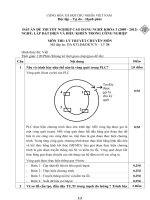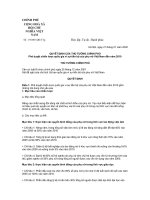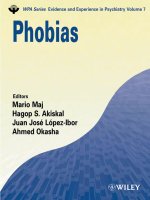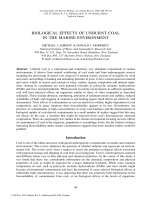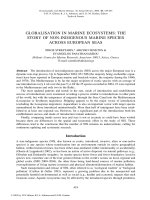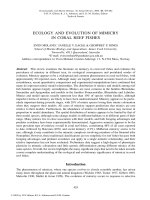2002 volume 43 1 33 422 KOLBACH INDEX
Bạn đang xem bản rút gọn của tài liệu. Xem và tải ngay bản đầy đủ của tài liệu tại đây (61.91 KB, 10 trang )
J. Appl. Genet. 43(1), 2002, pp. 33-42
Interaction of gene effects with environments
for malting quality of barley doubled haploids
Zygmunt KACZMAREK1, Maria SURMA1, Tadeusz ADAMSKI1, Stanis³aw JE¯OWSKI1,
Roman MADAJEWSKI2, Karolina KRYSTKOWIAK1, Anetta KUCZYÑSKA1
1
2
Institute of Plant Genetics, Polish Academy of Sciences, Poznañ, Poland
Plant Breeding Group "Szelejewo", Breeding Station £agiewniki, Poland
Abstract. Barley doubled haploids covering a wide range of malting quality, along
with their parental cultivars and F2, F3 hybrids, were investigated in six environments
(three locations, two years) to study the genotype-environment (G × E) interaction
structure and the influence of environments on additive, dominance and epistatic gene
effects. Grain and malt characters, such as 1000-grain weight, percentage of plump kernels, malt extract yield, protein content, Kolbach index and malt fine-coarse difference
(FCD), were measured. Main effects for genetic parameters were estimated and regression analysis was used to explain the interaction of gene effects with environments.
The results show that additive effects had the greatest interaction with environments for
all the analysed traits, but only for malt characters this interaction was linear. Interaction of dominance effects was much lower and only in the case of 1000-grain weight,
protein content and Kolbach index it proved to be significant. The results suggest that
effects of heterozygous loci are more stable in contrasting environments than effects
of homozygous loci.
Key words: barley, doubled haploids, genetic parameters, GE interaction, malting quality.
Introduction
Malt and grain characters are inherited quantitatively and their phenotypic performance is dependend on both genetic factors and environmental conditions
(EAGLES et al. 1995, MOLINA-CANO et al. 1997, KACZMAREK et al. 1999). Besides year and location effects, genotype-environment (G × E) interaction for malt
characters in barley cultivars and lines was also observed (EAGLES et al. 1995,
KACZMAREK et al. 1999).
Received: May 25, 2001. Accepted: October 30, 2001.
Correspondence: Z. KACZMAREK, Institute of Plant Genetics, Polish Academy of Sciences,
ul. Strzeszyñska 34, 60-479 Poznañ, Poland, e-mail:
34
Z. Kaczmarek et al.
Information on genetic determination of quantitative traits may be obtained by
estimation of genetic parameters determining additive [d], dominance [h]
and epistatic (additive × additive [i], additive × dominance [j] and dominance ×
dominance [l]) gene effects. These genetic parameters have been defined as a sum
of individual effects of all segregating loci, with the assumption of equal effect in
each locus (MATHER, JINKS 1982). Estimators of the parameters are some functions of mean values of the proper generation set, i.e., parents and hybrids (P1, P2,
F1, F2, F3, B1, B2) and/or homozygous lines derived from a cross between two homozygous parents (MATHER, JINKS 1982, SURMA et al. 1984, 1997).
As phenotypic values of traits are conditioned by both genetic and environmental
factors, mean values of hybrids and lines may change depending on conditions in
which the experiments have been performed. The presence of genotype-environment interaction may greatly influence the differences between
the studied generations, thus influencing values of estimates of genetic parameters. Therefore, to obtain credible information on inheritance of quantitative traits,
the G × E interaction should be taken into account in the genetic analysis. Such
an analysis was described by KACZMAREK (1986) for GCA (general combining
ability) and SCA (specific combining ability) parameters, and by ADAMSKI
(1993) and ADAMSKI et al. (1996) for genetic parameters [d], [h], [i] and [l].
The aim of the present paper was to study the structure of interaction of additive, dominance and epistatic gene effects with environments for grain and malt
characters of barley doubled haploid (DH) lines.
Material and methods
The materials for the study were 30 barley DH lines derived from F1 hybrids Grit
× Havila, the parental cultivars, and F2 and F3 hybrids. These generations were
studied in a series of field experiments carried out in six environments (three locations: Cerekwica, Kruszwica, £agiewniki in two years: 1995, 1996) denoted here
as CER95, KRU95, LAG95, CER96, KRU96, LAG96. The locations differed
mainly in soil type: Cerekwica – poor, sandy-clay soil, Kruszwica and £agiewniki
– rich, loamy soil. In each environment the experiment was conducted in a randomized block design with three replications. The following grain and malt characters were analysed: 1000-grain weight, percentage of plump kernels, malt
protein content, ratio of soluble protein to crude protein (Kolbach index), malt extract yield, and malt fine-coarse difference. A detailed description of the experiments and the methods applied for determining grain and malt characters was
presented by KACZMAREK et al. (1999).
Statistical analyses
Additive, dominance and nonallelic interaction effects were estimated on the basis of mean values of extreme lines (DHmax, DHmin), the mean value of all the lines
(DHm) and the means of F2 and F3 hybrids (SURMA et al. 1997). The extreme lines
Interaction of gene effects with environments
35
were chosen on the basis of mean performance of studied lines across environments.
The study of interaction of gene effects with environments followed the procedure described by KACZMAREK (1986) and KACZMAREK et al. (2000).
This method allows estimation and testing of the mean effects of genetic parameters, analysis of the interactions of individual parameters with environments, and
explanation of this interaction by means of linear regression of interaction effects
on environmental effects.
Results
Mean values of studied traits over environments for all DH lines, lines with minimum and maximum values of these traits, as well as for parents and F2 and F3 hybrids, are presented in Table 1. The largest differences between extreme lines
in environments, reaching up to 35% of the value, were observed for fine-coarse
difference, percentage of plump kernels and 1000-grain weight. The smallest differences were recorded for malt extract yield and protein content (data not
shown).
Table 2 shows estimates of [d], [h], [i] and [l] parameters in each of the six environments. Marked differences in values and sign of these parameters estimated
in particular environments can be observed. An analysis of variance performed
for series of six experiments indicated a significant influence of environments
and G × E interaction on estimation of gene effects for all grain and malt characters. Mean estimates of gene effects over environments and results of testing
of their significance are presented in Table 3.
1000-grain weight
For 1000-grain weight additive gene effects and additive × additive epistasis
proved to be significant (F-statistic values are higher than F0.01 for [d] and higher
than F0.05 for [i]) (Table 3). These effects show also interaction with the environments. Interaction of additive effects with environments could not be explained by
regression because of the small value of determination coefficients (22.57%),
while in the case of additive × additive effects this relationship was linear, which
is evidenced by the significant value of regression coefficient (F = 33.80)
and a high coefficient of determination (89.42%). Mean estimates of the [h] and
[l] parameters, determining dominance and dominance × dominance effects, respectively, were not significant. Differences between environments in values and
sign of these parameters were observed (Table 2), but only for [h] parameter
F-statistic value for interaction was higher than the critical F-value at the level
of 0.05 (Table 3). Interaction of dominance effects [h] with environments may be
explained to some extent by linear regression (regression coefficient significant at
the level of 0.10, coefficient of determination 44.78%). The insignificant
36
Z. Kaczmarek et al.
Table 1. Mean values (over environments) for grain and malt characters of barley DH
lines, parental cultivars and F2, F3 hybrids
1000-grain
weight
(g)
Plump
kernels
(%)
Protein
content
(%)
Kolbach
index
(%)
Fine extract
(%)
Fine-coarse
difference
(%)
DHmax
50.94
88.86
13.30
40.97
81.40
6.87
DHmin
35.61
58.02
12.21
34.49
79.06
3.78
DHmean
44.11
78.87
12.81
37.64
80.22
5.17
Grit (G)
43.50
84.86
12.37
42.02
81.32
3.66
Havila (H)
45.09
84.17
12.86
35.12
79.07
5.94
F2 (G × H)
46.31
87.12
12.51
39.44
80.33
4.56
F3 (G × H)
45.34
85.62
12.67
44.72
80.48
4.47
Genotype
F-statistic value for interaction of parameter [l] shows that the variation in estimates of this parameter in environments was random, independent of changes in
environmental conditions.
Plump kernels
Mean estimates of all genetic parameters for percentage of plump kernels were
significantly different from zero, which indicates that phenotypic values of this
trait are influenced by additive, dominance and epistatic effects. A significant
(P < 0.01) interaction with environments was found only for additive and additive
× additive effects ([d] and [i] parameters), but its nature was indefinite because deviations from regression were significant (Table 3). Estimates of dominance and
dominance × dominance effects in individual environments were similar and had
the same (negative) sign (Table 2).
Protein content
Protein content in the studied population of DH lines was markedly influenced
by additive gene effects (a significant value of parameter [d]). Estimates of these
effects were dependent on environmental conditions, but only about 50% of
the observed interaction of these effects with environments could be explained
by means of linear regression (coefficient of regression was significant at the level
of 0.10, deviations from regression were significant at the level of 0.01). Mean estimates of parameters [h] and [l] were close to zero (Table 3). Table 2 shows that in
various environments values of these parameters differed in sign. F-statistic values for interaction and deviations from regression were higher than F0.01 for both
[h] and [l], which indicates that interaction of dominance and dominance × dominance effects with environments was not linear (Table 3).
37
Table 2. Estimates of genetic parameters for grain and malt characters in particular
environments
Environment
Parameter
KRU95
LAG95
CER95
CER96
LAG96
KRU96
1000-grain weight
[d]
6.55
8.17
7.60
9.96
7.90
5.83
[h]
16.03
3.22
–24.18
19.99
1.68
16.27
[i]
–0.83
–1.60
–1.26
0.75
–1.16
–0.90
[l]
–13.96
–0.29
37.57
–13.88
–6.11
–28.80
Plump kernels
[d]
16.33
9.35
21.00
15.00
17.67
13.17
[h]
53.73
13.03
17.60
31.53
32.87
76.14
[i]
–5.60
1.92
–12.25
–5.72
–7.36
–3.59
[l]
–43.19
–16.84
–21.50
–36.36
–35.82
–97.97
[d]
0.86
0.08
0.84
0.73
0.15
0.91
[h]
7.66
–4.29
–3.99
2.41
–1.12
–4.03
[i]
–0.49
–0.07
0.24
–0.19
–0.30
0.46
[l]
–15.65
4.81
3.24
–4.34
1.58
9.91
Protein content
Kolbach index
[d]
1.73
4.29
4.43
4.00
0.90
4..10
[h]
–6.10
22.33
21.24
–1.43
47.07
–15.12
[i]
–0.77
1.76
0.88
0.85
–2.38
0.19
[l]
15.25
–30.18
–20.34
1.20
–96.18
30.48
Fine extract
[d]
1.26
1.10
1.85
0.93
0.65
1.25
[h]
–4.25
2.53
8.61
–0.61
3.05
1.94
[i]
–0.41
–0.17
–0.08
0.60
0.46
–0.29
[l]
6.57
–2.94
–11.48
0.99
–6.10
–6.86
Fine-coarse difference
[d]
1.77
1.89
2.54
1.78
1.08
0.22
[h]
–1.83
–9.14
–2.09
–1.05
–3.98
–7.93
[i]
0.06
–0.35
1.05
–0.10
–0.32
0.64
[l]
1.71
12.43
2.60
2.70
3.53
14.48
38
Table 3. Mean estimates of genetic parameters and results of testing the hypotheses
concerning their interaction with environments
Parameter
Estimate
of parameter
F-statistic value for
parameter
interaction
Coefficient of
regression
determination
F-statistic value for
regression
deviations
1000-grain weight
[d]
7.67
173.50
4.34
0.56
22.57
1.17
4.20
1.89
[h]
5.50
0.68
2.74
9.04
44.78
5.24
[i]
–0.83
6.70
2.48
0.64
89.42
33.80
0.06
[l]
–2.21
0.06
1.47
–10.63
31.37
1.83
1.26
[d]
15.42
90.15
12.97
0.24
6.61
0.28
15.14
[h]
37.48
15.01
2.21
3.57
42.63
2.97
1.59
[i]
–5.43
8.22
5.89
–0.32
8.74
0.38
6.71
[l]
–41.95
12.40
0.91
-4.03
35.89
2.24
0.73
Plump kernels
Protein content
[d]
0.55
8.52
6.49
0.28
49.94
4.99
4.06
[h]
–0.56
0.08
3.41
1.17
7.97
0.35
3.92
[i]
–0.06
0.16
1.28
0.08
6.55
0.28
1.50
[l]
–0.08
0.00
3.22
–1.19
2.39
0.10
3.93
[d]
3.24
27.23
19.13
0.01
0.01
0.00
23.91
[h]
11.33
1.45
21.14
6.47
19.80
0.99
21.20
[i]
0.09
0.02
5.95
–0.07
0.56
0.02
7.40
[l]
–16.63
0.82
21.67
–14.25
25.43
1.36
20.20
[d]
1.17
50.86
2.73
–0.16
54.56
4.80
1.55
[h]
1.88
1.17
1.47
–0.11
0.24
0.01
1.83
[i]
0.02
0.01
0.97
0.16
53.62
4.62
0.56
[l]
–3.30
1.61
0.89
0.14
0.18
0.01
1.11
[d]
1.55
22.48
15.23
–0.78
53.84
4.67
8.79
[h]
–4.33
9.67
1.34
–2.99
43.69
3.10
0.94
[i]
0.16
0.50
2.53
0.00
0.00
0.00
3.17
[l]
6.24
7.31
0.99
4.56
37.08
2.36
0.78
4.06
1.86
4.54
1.96
Kolbach index
Fine extract
Fine-coarse difference
F 0.10
F 0.05
6.61
2.24
7.71
2.39
F0.01
16.26
3.06
21.20
3.37
Interaction of gene effects with environments
39
Kolbach index
For Kolbach index, like in the case of protein content, only mean estimates of additive effects proved to be significant. Estimates of the other parameters in individual environments differed in value and sign (Table 2) and mean estimates (over
environments) did not differ significantly from zero. A highly significant
(P < 0.01) interaction of all gene effects with environments was observed, although for no gene effects this interaction could be explained by means of regression (Table 3).
Fine extract
For fine extract only mean estimates of parameter [d] proved to be significant, indicating, however, an interaction with environments. This interaction may be explained to some extent by linear regression, since coefficient of determination was
54.56%, regression coefficient was significant at the level of 0.10, and the value
of the statistic for deviation from regression was not significant. Mean estimates
of the other parameters were not significant, and no interaction with environments
was detected (Table 3).
Fine-coarse difference
Analysis of malt fine-coarse difference indicated that additive, dominance
and dominance × dominance effects estimated over environments were significant (Table 3). Interaction of additive effects with environments was very high
(F-statistic for interaction amounted to 15.23, compared to F0.01 = 3.06). Analysis
of regression showed a partial (P = 0.10) linear relationship between [d] values
and environmental effects (determination coefficient 53.84%). Mean estimate
of parameter [i] was insignificant and in individual environments marked differences in the values and sign of this parameter can be observed (Table 2). Interaction of additive × additive effects with environments appeared to be significant
(at P = 0.05), but this interaction could not be explained by regression. Dominance
and dominance × dominance effects proved to be highly stable, which is evidenced by small and insignificant F-statistic values for interaction of [h] and [l]
parameters (Table 3).
Discussion
Results of the presented study show that the analysed traits were controlled mainly
by genes with additive effects. This applies both to grain characteristics
(1000-grain weight, percentage of plump kernels) and to malt characteristics (protein content, Kolbach index, extract yield, fine-coarse difference). In genetics
of quantitative traits, including the analysed malt and grain characteristics, additive effects are associated with homozygous loci (MATHER, JINKS 1982), so they
40
Z. Kaczmarek et al.
may be fixed as a result of selection. It is known that the level of homozygosity increases in successive generations. Thus, the impact of additive effects in the observed genetic variation of the population grows. In the case of DH lines, which
are a completely homozygous material, the observed genetic variation results
from additive and additive × additive gene effects (CHOO 1981, SNAPE 1997).
In the presented experiments, hybrids of early generations (F2, F3) were included,
whose expected means depend on effects of heterozygous loci (MATHER, JINKS
1982). Such experiments enabled broadening the scope of obtained genetic data
by estimation of dominance and dominance × dominance effects. Estimates
of those effects in individual environments showed marked differences in their
values and sign for all the analysed traits except percentage of plump kernels and
fine-coarse difference. This shows that selection for these traits in early generations may prove to be ineffective, because in the successive generations values
of selected breeding lines will be changing as a result of their increasing
homozygosity.
The applied statistical methods enabled determining to what extent the estimates of gene effects are dependent on the environment. The results showed that
additive effects had a great interaction with the environment for all the analysed
traits, but only for protein content, fine extract and fine-coarse difference this interaction could be explained by linear regression. Interaction of dominance effects
was much lower and only in the case of 1000-grain weight, protein content
and Kolbach index it proved to be significant. It should be noted that with the exception of Kolbach index, F-statistic values for interaction of additive effects with
environments were higher than those for dominance effects.
As it was mentioned earlier, in classical quantitative genetics the values of genetic parameters [d], [h], [i] and [l] are defined as the sums of corresponding gene
effects over all segregating loci. In the past decade a marked progress in molecular
genetics resulted in developing more precise methods for studying the inheritance
of metrical traits. These methods allow to locate quantitative trait loci (QTL),
to estimate the effect of individual QTL and to study QTL × environment interaction (QTL × E). TINKER et al. (1996) examined effects of QTL and QTL × E interaction for several agronomic traits in barley. They found the occurrence
of primary and secondary QTL × E interactions for – among others – yield
and kernel weight. Those interactions were caused mainly by changes in magnitude (not in sign) of allelic effect. HAYES et al. (1993) found QTL × E interaction
effects for yield and grain protein in barley DH lines. Effects of QTL for malt extract appeared to be constant across environments. In that study only additive effects were taken into account. In our studies we could examine, besides additive,
also dominance and epistatic effects, but only as a sum of the effects over all loci
conditioning grain and malt traits. Interaction with environments of dominance
and dominance × dominance effects, that was significant only in the case of protein content and Kolbach index, resulted from changes both in magnitude and sign
Interaction of gene effects with environments
41
of gene effects across environments, but interaction of additive effects was caused
only by changes in their magnitude.
The obtained results suggest that effects of heterozygous loci are more stable
in contrasting environments than effects of homozygous loci. This may result
in a lower adaptability of homozygous than heterozygous populations to varied
environmental conditions, which has been reported by some authors (e.g.,
SOLIMAN, ALLARD 1991, SURMA 1996). Probably for this reason the studied doubled haploid lines, as fully homozygous genotypes, appeared to be unstable
(KACZMAREK et al. 1999).
Acknowledgements. The study was supported by the Polish Committee for Scientific Research, Project No. 5PO6A03508.
REFERENCES
ADAMSKI T. (1993). The use of doubled haploid lines for genetic analysis of quantitative
traits. (in Polish). Treatises and Monographs No. 2, IGR PAN, Poznañ.
ADAMSKI T., KACZMAREK Z., SURMA M. (1996). Methods for statistical analysis of gene
action effects in a series of DH line experiments. In: COMPSTAT. Proceedings in
Computational Statistics (A. Prat, E. Ripoll, eds.): 147-148.
CHOO T.M. (1981). Doubled haploids for studying the inheritance of quantitative characters. Genetics 99: 525-540.
EAGLES H.A., BEDGOOD A.G., PANOZZO J.F., MARTIN P.J. (1995). Cultivar and environmental effects on malting quality in barley. Aust. Agric. Res. 46: 831-844.
HAYES P.M., LIU B.H., KNAPP S.J., CHEN F., JONES B., BLAKE T., FRANCKOWIAK J.,
RASMUSSON D., SORRELLS M., ULLRICH S.E., WESENBERG D., KLEINHOFS A.
(1993). Quantitative trait locus effects and environmental interaction in a sample
of North American barley germ plasm. Theor. Appl. Genet. 87: 392-401.
KACZMAREK Z. (1986). The analysis of a series of experiments in incomplete block designs (in Polish). Rocz. AR Poznañ 155: 1-117.
KACZMAREK Z., ADAMSKI T., SURMA M., LEŒNIEWSKA-FR¥TCZAK M. (2000). Estimation of gene effects in various environmental conditions. In: EUCARPIA Quantitative
Genetics and Breeding Methods: the Way Ahead (A. Gallais, C. Dillmann,
I. Goldringer, eds.), INRA, Paris: 27-34.
KACZMAREK Z., ADAMSKI T., SURMA M., JE¯OWSKI S., LEŒNIEWSKA-FR¥TCZAK M.
(1999). Structure of genotype-environment interaction of barley doubled haploids
with regard to malting quality. Plant Breeding 118: 243-247.
MATHER K., JINKS J.L. (1982). Biometrical Genetics (3rd edn.). Chapman and Hall, London.
MOLINA-CANO J.L., FRANCESCH M., PEREZ-VENDRELL A.M., RAMO T., VOLTAS J.,
BRUFAU J. (1997). Genetic and environmental variation in malting and feed quality
of barley. J. Cereal Sci. 25: 37-47.
SNAPE J.W. (1997). Application of doubled haploid lines in plant breeding and genetical
research: current issues and approaches. In: Advances in Biometrical Genetics. Proc.
42
Z. Kaczmarek et al.
10th Meet. EUCARPIA Section Biometrics in Plant Breeding (P. Krajewski,
Z. Kaczmarek, eds.): 35-46.
SOLIMAN K.M., ALLARD R.W. (1991). Grain yield in composite cross population of barley: effects of natural selection. Crop Sci. 31: 705-708.
SURMA M. (1996). Biometrical-genetic analysis of quantitative traits of hybrids and doubled haploids in spring barley (in Polish). Treatises and Monographs No. 3, IGR PAN,
Poznañ: 1-110.
SURMA M., ADAMSKI T., KACZMAREK Z. (1984). The use of doubled haploid lines for estimation of genetic parameters. Genet. Pol. 25: 27-32.
SURMA M., KACZMAREK Z., ADAMSKI T. (1997). Estimation of genetic parameters based
on doubled haploids and early generation. In: Advances in Biometrical Genetics. Proc.
10th Meet. EUCARPIA Section Biometrics in Plant Breeding (P. Krajewski,
Z. Kaczmarek, eds.), Poznañ: 281-284.
TINKER N.A., MATHER D.E., ROSSNAGEL B.G., KASHA K.J., KLEINHOFS A.,
HAYES P.M., FALK D.E., FERGUSON T., SHUGAR L.P., LEGGE W.G., IRVINE R.B.,
CHOO T.M., BRIGGS K.G., ULLRICH S.E., FRANCKOWIAK J.D., BLAKE T.K.,
GRAF R.J., DOFING S.M., SAGHAI MAROOF M.A., SCOLES G.J., HOFFMAN D.,
DAHLEEN L.S., KILIAN A., CHEN F., BIYASHEV R.M., KUDRNA D.A.,
STEFFENSON B.J. (1996). Regions of the genome that affect agronomic performance
in two-row barley. Crop Sci. 36: 1053-1062.

